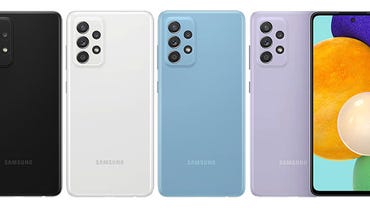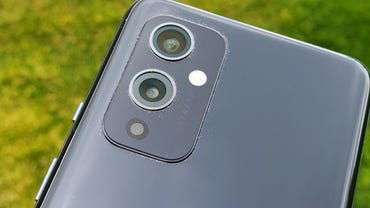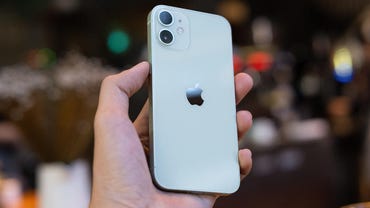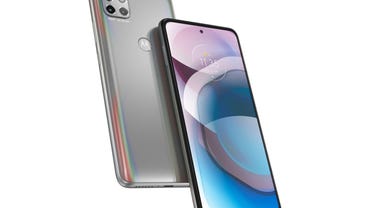Best cheap 5G phone 2021: Affordable 5G smartphones | ZDNet
Buying a 5G smartphone on a budget has never been more fun given discounts, steep competition among carriers and Android device makers, but there are trade-offs.
The 5G smartphone sweet spot is the $400 to $700 price band and there are some cases where you can get a solid device for under the $400 mark. Are there compromises? Sure, the camera is the biggest compromise, but most of the devices in the mid-range can snap good-enough photos. Recent launches from Google as well as Motorola highlight how the price-camera gap is closing a bit.
Your first step in buying a 5G device on the cheap is to ponder what you care about (and don’t). If the camera is everything, flagship devices will likely merit more consideration. However, smartphone vendors including Motorola, Google, Samsung, OnePlus and even Apple are bringing more flagship features down market.
And then there are discounts to be had. Motorola’s latest Edge is a quality near flagship device that’ll run you $599. The launch of the OnePlus 9 is going for $659 at the moment. Samsung’s A-series unveiling in global markets is all aimed at the value market. Google’s primary argument for the Pixel franchise is that you can get pure Android, regular updates, and a strong 5G device for not a lot of money. The Pixel 6 is on the border of the mid-priced range.
Here’s a look at the updated field for almost cheap 5G smartphones and the trade-offs required. I’ve tested most of the Android devices in the budget 5G market, but there are a few Apple devices to ponder too. I’d also recommend using this list as a starter list for brands. For instance, I listed one OnePlus device, but there are more in the category to consider. Ditto for Motorola, which plays heavily in the value space, as well as Google and Samsung.
Display: 6.4 inches (2,400 x 1,080-pixel resolution) OLED | CPU: Google Tensor | RAM: 8GB | Internal Storage: 128GB | Rear cameras: 50MP rear f/1.9 and 12MP f/2.2 ultra-wide (114-degree field-of-view) | Front camera: 8MP f/2.0 | Weight: 207g | Dust/water resistance: IP68
The recently launched Google Pixel 6 is a 5G phone that’s priced to compete — starting at $599 for the 128GB storage model. Though 128GB is plenty of space for most users, Google is banking on cloud storage and services like Pixel Pass to bridge the gap for those who are craving more.
For under $600, the Pixel 6 is equipped with a large 6.4-inch 90Hz display, a generous 4,614 mAh battery that supports fast and wireless charging, and an upgraded camera system, that when paired with Google’s strong computational photography, will set this phone apart from its competition.
With the Pixel 6 lineup, Google is also committing to three years of Android version updates and five years of security updates. That’s a feat that not many manufacturers will be able to match, let alone in the mid-priced market.
Pros:
- High quality and capable camera system
- Stress-free battery life
- Stock Android with little bloatware
- Five years of software updates
Cons:
- Large body may be uncomfortable to hold for some
- Lack of expandable storage slot
- No charger in the box
Good value on the border of flagship
Display: 6.7 inches (2,460 x 1,080-pixel resolution) 144Hz LCD | CPU: Qualcomm Snapdragon 778G | RAM: 8GB | Internal Storage: 256GB | Rear cameras: 108MP rear f/1.9 wide, 8MP f/2.2 ultrawide (119-degree field-of-view), and 2MP f/2.4 depth | Front camera: 32MP f/2.3 camera | Weight: 200g | Dust/water resistance: IP52
I’d argue that Motorola has the most interesting device portfolio when it comes to balancing innovation and value. The Motorola Edge is the lead dog of the portfolio and offers a few premium features, including a triple camera setup at the rear, a strong Android experience with all the Moto fix-ins, and a price currently under the $600 mark.
Other perks that matter include micro-SD card support (if the 256GB of internal storage does not suffice), 5G support if you’re in the T-Mobile or Verizon networks, a speedy TurboPower 30W charger in the box, and a 144Hz refresh rate display that even today’s flagships can’t match.
Pros:
- Triple camera setup provides flexibility
- Long battery life with an included charger
- Smooth 144Hz display
- Stunning Nebula Blue design
Cons:
- LCD panel can be hard to see outdoors
- Bloatware on carrier models
Picks up where Galaxy S20 FE left off
Display: 6.5 inches (2,400 x 1,080-pixel resolution) 120Hz AMOLED | CPU: Qualcomm Snapdragon 750G | RAM: 6GB | Internal Storage: 128GB | Rear cameras: 64MP rear f/1.8 wide, 12MP f/2.2 ultrawide (123-degree field-of-view), 5MP f/2.4 macro, and 5MP f/2.4 depth | Front camera: 32MP f/2.2 camera | Weight: 189g | Dust/water resistance: IP67
There are a lot of phones in Samsung’s Galaxy A range, all with a focus on mid-range pricing. The Galaxy A52 5G is the cream of the current crop — a 5G handset with IP67 certification against dust and water ingress. Then there’s the 6.5-inch screen’s 120Hz refresh rate, that when paired with the dual speakers, makes for an immersive multimedia experience.
ZDNet’s Sandra Vogel gave the device high remarks when first launched, praising the A52 5G for its distinctive design, durability, and accouterment of smartphone perks like a MicroSD card slot and 3.5mm headphone jack. All of this comes at a price to beat at $499.99.
Pros:
- Reliably 64MP main camera with OIS
- Immersive 120Hz display
- IP67 rating for dust and water resistance
- Has most, if not all, essential smartphone features
Cons:
- Macro camera and depth sensor is unnecessary
- Digital zoom only
Display: 6.55 inches (2,400 x 1,080-pixel resolution) 120Hz AMOLED | CPU: Qualcomm Snapdragon 888G | RAM: 8GB | Internal Storage: 128GB | Rear cameras: 48MP rear f/1.8 wide, 50MP f/2.2 ultrawide (113-degree field-of-view), and 2MP f/2.4 monochrome| Front camera: 16MP f/2.4 camera | Weight: 192g | Dust/water resistance: IP68 (T-Mobile version only)
The OnePlus 9 started at $729, but now has sells below the $600 mark and therefore makes the cut for the 5G value category. Earlier this year, ZDNet’s Matthew Miller gave the device high marks with few tradeoffs relative to the OnePlus 9 Pro. But when compared with other 5G phones in the mid-priced category, there are some standout features that put this device ahead of the pack.
The OnePlus 9 features the latest Snapdragon 888 processor, the same chipset that resides in the flagship devices by Samsung, Oppo, and other Android manufacturers. That, on its own, brings an ample amount of firepower to get you through the most graphic-intensive tasks like gaming and video editing. The other key feature of this device is the new Hasselblad-partnered camera system. The OnePlus 9 sports the same ultrawide lens as its Pro sibling, so you can expect natural-looking stills and video.
Pros:
- Flagship-level performance
- 65W Warp Charging included in the box
- Stellar cameras
- Volume mode switch
Cons:
- IP68 rating on T-Mobile version only
- No mmWave 5G support
Display: 5.4 inches (2,340 x 1,080-pixel resolution) OLED | CPU: A14/15 Bionic chip | RAM: 4GB | Internal Storage: 64GB/128GB/256GB/512GB | Rear cameras: 12MP rear f/1.6 wide and 12MP f/2.4 ultrawide (120-degree field-of-view)| Front camera: 12MP f/2.2 camera | Weight: 135/141g | Dust/water resistance: IP68
The Apple iPhone 12 mini and iPhone 13 mini take the last spot on our list for offering the best of Apple in compact and 5G-ready packages. Both iPhones sport a 5.4-inch screen and weigh in at 135g and 141g, respectively, making them some of the most ergonomic smartphones on the market.
Even though the devices are just the opening act for its larger siblings, the iPhone 12 and 13 mini make for great 5G value, especially with the former getting a price discount thanks to the release of the latter. If you reminisce the smaller iPhone days and buying on a budget, the iPhone 12 mini starts at $599 for the 64GB model. For twice the storage, the latest A15 Bionic chip, and upgraded cameras, the iPhone 13 mini starts at $699.
Pros:
- Arguably the most compact phones in the market
- Industry-leading software support
- Reliable cameras
- Seamless integration within the Apple ecosystem
Cons:
- Subpar battery life
- No telephoto camera
Stock Android, with the latest updates
Display: 6.34 inches (2,400 x 1,080-pixel resolution) OLED | CPU: Snapdragon 765G | RAM: 6GB | Internal Storage: 128GB | Rear cameras: 12.2MP rear f/1.7 wide and 16MP f/2.2 ultrawide (119-degree field-of-view)| Front camera: 8MP f/2.0 camera | Weight: 183g | Dust/water resistance: IP67
Starting at $449, the Pixel 5a 5G enters the budget device fray with a few unique advantages. ZDNet’s Jason Cipriani touted the phone as “the best of Pixel for less”, citing its excellent battery life, stock Android experience, and reliable cadence of software updates. While the Pixel 5a 5G isn’t the latest and greatest offering by Google — that would be the Pixel 6 and 6 Pro — the device is still a great value offering for those looking to get their hands on 5G.
From a hardware perspective, the Pixel 5a 5G fields a large, yet comfortable, 6.34-inch OLED display with a body design that we’ve become accustomed to when talking Pixel. A large 4,680mAh battery, Qualcomm Snapdragon 765G processor, and stock Android make for a clean and minimal smartphone experience that should comfortably last you a day and some more.
Pros:
- Bloat-free stock Android
- Excellent software support
- Day-long battery life
- Reliable cameras
Cons:
Motorola One 5G Ace builds on the Motorola One 5G with a price tag under $400. Motorola, owned by Lenovo, has a full range of value devices, but this mid-range smartphone is compelling.
Simply put, it’s a good value for the money and the 6.7-inch display feels good in one hand. The camera system — four cameras on the back and two for selfies in the front — is solid in my tests. There are some areas where Motorola cut corners with a plastic backing, but overall the device feels flagship enough at a good price.
One key item here is that the Motorola One 5G has 6GB of memory with 128GB of storage with microSD card support. Typically, budget phones scrimp on storage and memory. The microSD card support in Motorola One 5G Ace allows you to bulk up a bit if necessary.
Motorola’s approach to Android rhymes with Google’s stock version of the operating system. A 48MP camera and a solid display round out the Motorola One 5G Ace perks. The Motorola One 5G Ace takes over the the Motorola One 5G in this ranking.
For all the latest Technology News Click Here
For the latest news and updates, follow us on Google News.





